A Bridge, a Tunnel, and a Subway
Prev
Next


|
Day 16: June 24, 2011 A Bridge, a Tunnel, and a Subway |
Prev Next |
 
|
|
|

 The conference is officially over but both co-chairs are leading
post-conference tours. Today Paul Gilger of the California Chapter led a
group up the Donner Pass. Paul did a good job in his
lead car but the occasional pointer from Sharon
was appreciated. We headed north on the west side of Lake Tahoe with
thoughts of frequent photo stops. I actually stopped less than I thought I
might because every pull off was filled with cars and people. And this is
not the busy season.
The conference is officially over but both co-chairs are leading
post-conference tours. Today Paul Gilger of the California Chapter led a
group up the Donner Pass. Paul did a good job in his
lead car but the occasional pointer from Sharon
was appreciated. We headed north on the west side of Lake Tahoe with
thoughts of frequent photo stops. I actually stopped less than I thought I
might because every pull off was filled with cars and people. And this is
not the busy season.
|
|
|
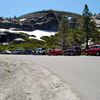
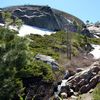 We made a stop by the side of the road to photograph the underside of the
bridge.
We made a stop by the side of the road to photograph the underside of the
bridge.
|
|
|


 Then a stop in the parking area next to the bridge let us see where we'd
just been and Donner Lake, too. The deck of the bridge is curved, banked,
and rises from one end to the other. Pretty fancy for something built in
1924, eh?
Then a stop in the parking area next to the bridge let us see where we'd
just been and Donner Lake, too. The deck of the bridge is curved, banked,
and rises from one end to the other. Pretty fancy for something built in
1924, eh?
|
|
|
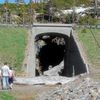

 At over 1600 feet in length, Tunnel #6 was the longest on the Cross
Continental Railroad. One of the earliest uses of nitroglycerin was right
here where thousands of Chinese laborers blasted away tons of rock in an
innovative "four face" attack. In order to speed things along,
an eight by twelve foot vertical shaft was blasted into the tunnel's
midpoint. Once some space was established, work progressed from the middle
toward both end as well as from both ends toward the middle. In another
innovation, rubble and workers rode an "elevator" on cables
pulled by the wheels of a steam locomotive.
At over 1600 feet in length, Tunnel #6 was the longest on the Cross
Continental Railroad. One of the earliest uses of nitroglycerin was right
here where thousands of Chinese laborers blasted away tons of rock in an
innovative "four face" attack. In order to speed things along,
an eight by twelve foot vertical shaft was blasted into the tunnel's
midpoint. Once some space was established, work progressed from the middle
toward both end as well as from both ends toward the middle. In another
innovation, rubble and workers rode an "elevator" on cables
pulled by the wheels of a steam locomotive.
Hopes of driving though the abandoned tunnel were dashed by lots of remaining snow. So we walked in. Not far enough to see that vertical shaft at the midpoint but far enough to appreciate the size of the tunnel and the effort it represents. |
|
|
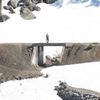
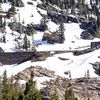
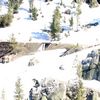
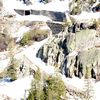
 Tunnels #7 & #8, seen in the first photograph in this panel, closely
followed #6. When they were in active use, the space between was covered
by snow sheds. No equipment existed that was capable of clearing the
tracks of several feet of snow so prevention was the chosen cure. Crossing
the railroad in an automobile involved opening doors in the sides of the
snow shed, driving over the bare (no graded crossing here) rails at an
angle (those doors were offset), then closing the doors. There was ample
opportunity for a car to stall or get stuck. Quite a few of the folks who
opened the doors weren't around to close them. A big locomotive can really
do a number on a stalled Model T and everything and everyone in it.
Tunnels #7 & #8, seen in the first photograph in this panel, closely
followed #6. When they were in active use, the space between was covered
by snow sheds. No equipment existed that was capable of clearing the
tracks of several feet of snow so prevention was the chosen cure. Crossing
the railroad in an automobile involved opening doors in the sides of the
snow shed, driving over the bare (no graded crossing here) rails at an
angle (those doors were offset), then closing the doors. There was ample
opportunity for a car to stall or get stuck. Quite a few of the folks who
opened the doors weren't around to close them. A big locomotive can really
do a number on a stalled Model T and everything and everyone in it.
The Lincoln Highway really improved things here. That curved line in the foreground of the second picture was once the LH. It led to a short tunnel that passed under the railroad and became known as the Lincoln Highway Subway. These five photos were taken from three different pull-offs. 1 & 2 are from one location, 3 is from a point just a bit lower, and 4 & 5 are from a point even lower. The "subway" is visible in all of the last three. In the last one, Ken, whose wife was seen directing traffic in the first panel, is standing atop the "subway". I only learned that later. When I took the picture, I had no idea who it was standing dead center in my field of view. |
|
|
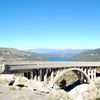 This is the "other" side of the bridge taken from the pull-off
that is positioned for looking straight through the "subway".
This is the "other" side of the bridge taken from the pull-off
that is positioned for looking straight through the "subway".
|
|
|
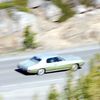 I would have sworn that I had several photographs of Jim Armstrong's
Pontiac but when I went looking, this was pretty much it. It was taken
from the bridge area after the tour had officially ended and Jim was
driving through the loops below. All of Jim's cars have been Pontiacs;
Both of them. His first car was a brand new 1966 two-door which he drove
until someone stole it seventeen years later. By then, Jim's father had
passed away and his 1971 Le Mans was sitting in the garage. So Jim started
driving it and he's still driving it twenty-eight years and 350,000 miles
later.
I would have sworn that I had several photographs of Jim Armstrong's
Pontiac but when I went looking, this was pretty much it. It was taken
from the bridge area after the tour had officially ended and Jim was
driving through the loops below. All of Jim's cars have been Pontiacs;
Both of them. His first car was a brand new 1966 two-door which he drove
until someone stole it seventeen years later. By then, Jim's father had
passed away and his 1971 Le Mans was sitting in the garage. So Jim started
driving it and he's still driving it twenty-eight years and 350,000 miles
later.
|
|
|
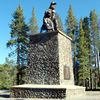
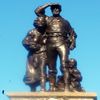 Because of construction and fees,the group had skipped the Donner Monument
on the way up. I stopped on the way back to South Tahoe and parked outside
the fence.
Because of construction and fees,the group had skipped the Donner Monument
on the way up. I stopped on the way back to South Tahoe and parked outside
the fence.
|
|
|

 The discount at Harvey's had expired with the conference so I moved down
the road. This is the same motel with adjacent brewery where I stayed in
2009. They look like
this and this on the
inside.
The discount at Harvey's had expired with the conference so I moved down
the road. This is the same motel with adjacent brewery where I stayed in
2009. They look like
this and this on the
inside.
|
|
|
| [Prev] [Site Home] [Trip Home] [Contact] [Next] |